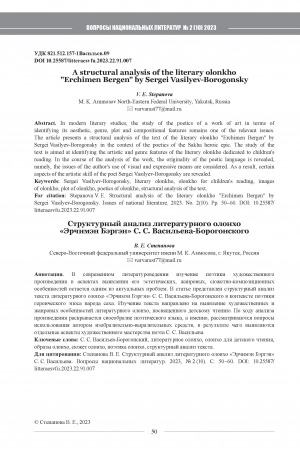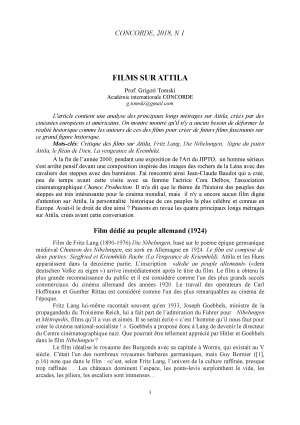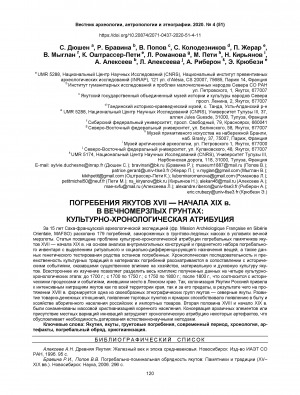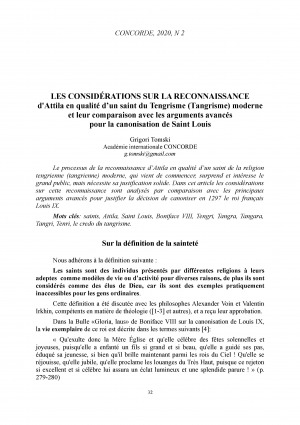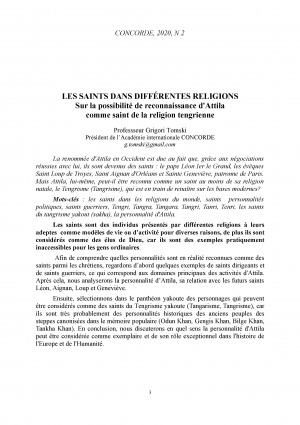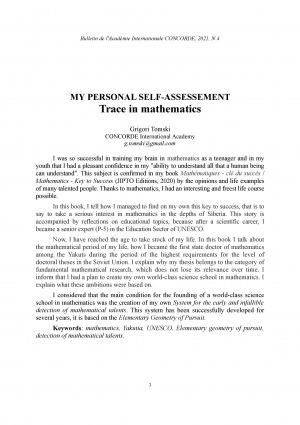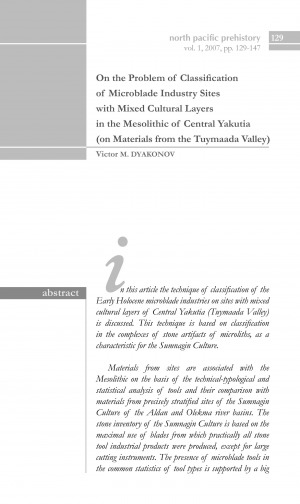- Книга (3589)
- Газета (3)
- Журнал (22)
- Автореферат диссертации (182)
- Изоиздание (11)
- Аудиоиздание (10)
- Видеоиздание (234)
- Картографическое издание (31)
- Неопубликованный документ (16)
- Нотное издание (1)
- Фотография (13)
- Статья (977)
- Библиографический указатель (240)
- Словарь (8)
- Календарь (4)
- Брошюра (76)
- Буклет (24)
- Игра (1)
- Веб-архив (322)
- Не указан (2)
- Литературно-художественные издания (367)
- Официальные издания (117)
- Научные издания (1519)
- Научно-популярные издания (2041)
- Информационные издания (855)
- Справочные издания (95)
- Учебные издания (140)
- Производственно-практические издания (3)
- Массово-политические издания (608)
- Изобразительное издание (17)
Количество страниц: 11 с.
Степанова, В. Е. A structural analysis of the literary olonkho "Erchimen Bergen" by Sergei Vasilyev-Borogonsky / В. Е. Степанова ; Северо-Восточный федеральный университет имени М. К. Аммосова // Вестник Северо-Восточного федерального университета им. М. К. Аммосова. Серия "Вопросы национальных литератур". - 2023. - N 2 (10). - С. 50-60. - DOI: 10.25587/litteraesvfu.2023.22.91.007
DOI: 10.25587/litteraesvfu.2023.22.91.007
Количество страниц: 13 с.
Древнейшие памятники дюктайской культуры найдены и в Северной Америке — на Аляске и прилегающих к ней территориях Канады.В настоящее время у ученых почти не вызывает сомнения предположение, что именно из Северо-Восточной Азии (из Якутии через Чукотку и Аляску) происходило и первоначальное заселение человеком Нового Света. Считается аксиомой, что Америка изначально была безлюдной и что континент был заселен человеком современного физического типа (Homo sapiens) из Азии через области, примыкающие к Берингову проливу, по Берингийскому сухопутному мосту, соединяющему Чукотку с Аляской.
Mochanov, Ju. A. Early migrations to America in the light of a study of the Dyuktai paleolithic culture in Northeast Asia / Ju. A. Mochanov // Early Native Americans : prehistoric demography, economy, and technology. — The Hague ; Paris ; New York : Mouton publishers, 1980. — P. 119-131.
Количество страниц: 16 с.
- Краеведение. Археология. География. Биографии. История > Историческая наука. Историография > Всеобщая история. История отдельных стран и народов,
- Искусство. Фотография. Музыка. Игры. Спорт > Развлечения. Зрелища. Игры,
- НАУКА ЯКУТИИ > КРАЕВЕДЕНИЕ. ГЕОГРАФИЯ. БИОГРАФИИ. ИСТОРИЯ > Историческая наука. Историография > Всеобщая история,
- НАУКА ЯКУТИИ > ИСКУССТВО. ФОТОГРАФИЯ. МУЗЫКА. ИГРЫ. СПОРТ > Развлечения. Зрелища. Игры.
Tomski, G. V. Films sur Attila / Tomski Grigori ; Académie Internationale CONCORDE // Concorde. – 2018. – N 1. – С. 3-17.
Количество страниц: 12 с.
- Общественные науки. Образование > Этнография. Обычаи. Жизнь народа. Нравы,
- Краеведение. Археология. География. Биографии. История > Историческая наука. Историография > Археология,
- НАУКА ЯКУТИИ > ОБЩЕСТВЕННЫЕ НАУКИ > Этнография. Обычаи. Жизнь народа. Нравы,
- НАУКА ЯКУТИИ > КРАЕВЕДЕНИЕ. ГЕОГРАФИЯ. БИОГРАФИИ. ИСТОРИЯ > Историческая наука. Историография > Археология.
Frozen graves of Yakutia, a chronological sequence / S. Duchesne, R. Bravina, V. Popov [и др.] // Вестник археологии, антропологии и этнографии. – 2020. – N 4 (51). – С. 120-130. — DOI: 10.20874/2071-0437-2020-51-4-11.
DOI: 10.20874/2071-0437-2020-51-4-11
Количество страниц: 42 с.
- Томский Григорий Васильевич > Труды, статьи,
- Краеведение. Археология. География. Биографии. История > Историческая наука. Историография > Всеобщая история. История отдельных стран и народов,
- НАУКА ЯКУТИИ > КРАЕВЕДЕНИЕ. ГЕОГРАФИЯ. БИОГРАФИИ. ИСТОРИЯ > Историческая наука. Историография > Всеобщая история.
Tomski, G. V. Les considérations sur la reconnaissance d'Attila en qualité d’un saint du tengrisme (tangrisme) moderne et leur comparaison avec les arguments avancés pour la canonisation de saint louis = Доводы в пользу признания Аттилы святым современного тенгризма (тангризма) и их сравнение с аргументами о канонизации Святого Людовика / Tomski Grigori ; Académie internationale CONCORDE // Concorde. – 2020. – N 2. – С. 32-72.
Количество страниц: 30 с.
- Томский Григорий Васильевич > Труды, статьи,
- Краеведение. Археология. География. Биографии. История > Историческая наука. Историография > Всеобщая история. История отдельных стран и народов,
- НАУКА ЯКУТИИ > КРАЕВЕДЕНИЕ. ГЕОГРАФИЯ. БИОГРАФИИ. ИСТОРИЯ > Историческая наука. Историография > Всеобщая история.
Tomski, G. V. Les saints dans différentes religions sur la possibilité de reconnaissance d'Attila comme saint de la religion tengrienne / Tomski Grigori ; Académie internationale CONCORDE // Concorde. – 2020. – N 2. – С. 3-31.
Количество страниц: 64 с.
- Томский Григорий Васильевич > Труды, статьи,
- Математика. Естественные науки > Математика,
- Краеведение. Археология. География. Биографии. История > Биографии. Генеалогия. Геральдика,
- НАУКА ЯКУТИИ > МАТЕМАТИКА. ЕСТЕСТВЕННЫЕ НАУКИ > Математика,
- НАУКА ЯКУТИИ > КРАЕВЕДЕНИЕ. ГЕОГРАФИЯ. БИОГРАФИИ. ИСТОРИЯ > Биографии. Генеалогия. Геральдика.
Tomski, G. V. My personal self-assessement : trace in mathematics / Grigori Tomski ; CONCORDE International Academy // Bulletin de l’Académie Internationale CONCORDE. - 2021. – N 4. – С. 3-65.
Количество страниц: 19 с.
Работа посвящена проблеме изучения мезолита в Центральной Якутии. Здесь было известно небольшое количество стоянок сумнагинской культуры, характеризующихся смешанными культурными комплексами, и датированных этим временем лишь по аналогиям инвентаря. В работе предложена методика определения раннеголоценовых комплексов в смешанных культурных слоях, основанная на выделении в общих комплексах каменного инвентаря микролитов, в большей степени характерных для сумнагинской культуры. Проведённый анализ позволил выделить сумнагинский культурный комплекс на 11 памятниках Туймаады. На ещё около 25 памятниках, где обнаружены микропластинчатые индустрии, при расширении работ, может подтвердиться предположение о наличии в культурных слоях мезолитического каменного инвентаря
Dyakonov, V. M. On the Problem of Classification of Microblade Industry Sites with Mixed Cultural Layers in the Mesolithic of Central Yakutia (on Materials from the Tuymaada Valley) / Victor M. Dyakonov // North Pacific Prehistory : archaeological studies journal. — 2007. — Vol. 1. — P. 129-147.
Количество страниц: 302 с.
Количество страниц: 28 с.
- Томский Григорий Васильевич > Произведения,
- Краеведение. Археология. География. Биографии. История > Историческая наука. Историография > Всеобщая история. История отдельных стран и народов,
- Искусство. Фотография. Музыка. Игры. Спорт > Развлечения. Зрелища. Игры,
- НАУКА ЯКУТИИ > КРАЕВЕДЕНИЕ. ГЕОГРАФИЯ. БИОГРАФИИ. ИСТОРИЯ > Историческая наука. Историография > Всеобщая история,
- НАУКА ЯКУТИИ > ИСКУССТВО. ФОТОГРАФИЯ. МУЗЫКА. ИГРЫ. СПОРТ > Развлечения. Зрелища. Игры.
Tomski, G. V. Pour une image véridique d'Attila / Tomski G. ; Académie Internationale CONCORDE // Concorde. – 2018. – N 1. – С. 18-45.
